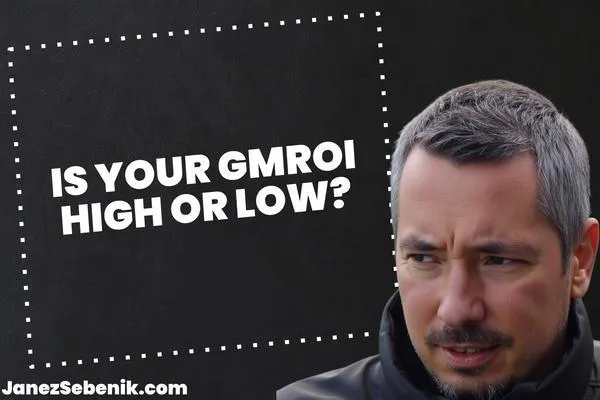
What is the difference between ROI and GMROI?
ROI and GMROI are two important metrics in business. But what's the difference? Let's break it down.
ROI looks at the big picture. It tells you how well your entire business is doing. GMROI, on the other hand, zooms in on your inventory. GMROI measures how much profit you make from each dollar invested in inventory.
Think of ROI as your overall health check. GMROI? It's like checking your heart rate during a workout. Both matter, but they tell you different things. GMROI helps you make smart choices about what to stock. ROI shows if your whole business strategy is working.
Key Takeaways
ROI measures overall business performance, while GMROI focuses on inventory profit
GMROI helps retailers make smarter inventory decisions
Both metrics are crucial for a complete picture of business health
Understanding the Basics
ROI and GMROI are key metrics for measuring business success. They help you figure out if your money's working hard enough for you.
ROI Explained
ROI, or Return on Investment, is like your business report card. It tells you how much money you're making compared to what you put in.
Here's how it works:
You invest $100 in your business
You make $150 back
Your ROI is 50%
Simple, right? ROI looks at everything - all your costs and all your cash coming in. It's the big picture of your business health.
But here's the kicker: ROI doesn't care where your profits come from. It just wants to know if you're in the green.
GMROI Explained
Now, GMROI is ROI's cool cousin. It stands for Gross Margin Return on Investment. It's all about your inventory game.
GMROI asks:
How much profit are you making from your stock?
Is your inventory earning its keep?
Here's the math: GMROI = (Sales - Cost of Goods) / Average Inventory Cost
It's like a spotlight on your shelves. GMROI tells you if your products are pulling their weight.
High GMROI? You're an inventory wizard. Low GMROI? Time to shake things up.
Dissecting GMROI
GMROI is a powerful tool for retailers. It helps you figure out if your inventory is making you money or just taking up space. Let's break it down.
Components of GMROI
GMROI has two main parts: gross profit and average inventory.
Gross profit is what you make after subtracting the cost of goods from your sales. It's the money left in your pocket after you've paid for the stuff you're selling.
Average inventory is the value of your stock over time. It's like taking a snapshot of your shelves and seeing how much cash is sitting there.
These two work together to show if your inventory is pulling its weight.
Calculating GMROI
Ready for some math? Don't worry, it's not too scary.
Here's the GMROI formula:
GMROI = Gross Profit / Average Inventory
Let's break it down:
Add up your total sales
Subtract the cost of goods sold
That's your gross profit
Now, figure out your average inventory
Divide gross profit by average inventory
Boom! You've got your GMROI.
Interpreting GMROI Values
So you've got your number. Now what?
A GMROI of 1 means you're breaking even. Anything less, and you're losing money. Aim higher!
A good GMROI varies by industry, but generally:
3 or higher: You're killing it!
2-3: You're doing okay
1-2: Room for improvement
Below 1: Time to rethink your strategy
High GMROI? Your inventory management is on point. Low GMROI? You might need to adjust your pricing or clear out some slow movers.
Remember, GMROI is just one piece of the puzzle. Use it with other metrics to get the full picture of your business health.
Inventory Metrics
Inventory metrics help you make smart money moves with your stock. They show if you're squeezing every penny out of what's on your shelves.
Inventory Cost and COGS
Your inventory cost is what you pay to get products on your shelves. It's not just the price tag - think shipping, handling, and storage too.
Cost of Goods Sold (COGS) is what it costs you to sell those items. It's a key player in your gross margin calculations.
Want to boost profits? Keep an eagle eye on these numbers. The lower your inventory cost and COGS, the fatter your margins.
But don't go too lean. Running out of stock is a surefire way to lose sales and annoy customers.
Inventory Turnover and Profitability
Inventory turnover is how fast you're selling your stuff. A high turnover rate means you're moving products quickly. That's usually good news.
Quick turnover reduces carrying costs. Less time on the shelf means lower storage fees and less risk of items going out of style.
But here's the kicker: turnover alone doesn't tell the whole story. You need to look at profitability too.
Enter Gross Margin Return on Inventory (GMROI). This metric shows how much profit you're making for every dollar invested in inventory.
A high GMROI means you're getting a good bang for your buck. It's a sign you're picking winners when it comes to what to stock.
Strategic Financial Analysis
Want to make smart money moves in retail? Let's dive into how GMROI and ROI can help you crush it. These metrics are your secret weapons for boosting profits and making killer investment choices.
Investment Decisions in Retail Business
Ever wonder how the big dogs in retail decide where to put their cash? It's all about GMROI, baby. This bad boy tells you how much moolah you're making from your inventory investment.
Here's the deal: GMROI looks at your gross margin and inventory investment. It's like a superpower for your business. You can use it to figure out which products are winners and which ones are duds.
Got a product with a high GMROI? Boom! That's where you want to invest more. Low GMROI? Time to cut that dead weight or find ways to juice it up.
Benchmarking Against Industry Averages
Now, let's talk about keeping up with the Joneses - or in this case, your competitors. You gotta know where you stand, right?
Compare your GMROI to the industry average. Are you crushing it or getting crushed? This comparison is gold for investors and managers.
If you're below average, it's time to roll up your sleeves. Look at your cost of goods sold (COGS) and see where you can trim the fat. Maybe you need to negotiate better deals with suppliers or streamline your operations.
Above average? Pat yourself on the back, but don't get cocky. Keep pushing to widen that gap and stay ahead of the pack. Remember, in retail, you're only as good as your last sale.
Driving Business Growth
Using ROI and GMROI can supercharge your retail business. These metrics help you make smarter decisions about pricing and inventory. Let's dive into how you can use them to boost your bottom line.
Implementing Effective Pricing Strategies
Want to make more money? Start with your pricing. Use GMROI to figure out which products are your real moneymakers. Look for items with a high GMROI - these are your cash cows.
Once you've found them, bump up their prices a bit. Don't go crazy, but a small increase can make a big difference in your net sales revenue.
For products with a low GMROI, try running a sale. Clear them out fast and use that cash for better-performing inventory. It's like trading in your old clunker for a shiny new sports car.
Remember, pricing isn't set in stone. Keep tweaking and testing. What works today might not work tomorrow.
Optimizing Inventory for Cash Flow
In retail, cash flow is king. And your inventory? That's where your cash is tied up.
Use GMROI to spot which products are holding you back. Got items with a low GMROI? They're eating up your cash.
Sell them off, even at a discount. It's better to have cash in hand than dusty inventory on your shelves.
Focus on stocking high-GMROI products. They're your inventory investments that pay off big time.
Order these more often, but in smaller batches. This keeps your cash flowing and your shelves stocked with winners.
Don't forget to track your overall inventory levels. Too much stock ties up cash. Too little means missed sales.
Find that sweet spot and watch your business grow.
